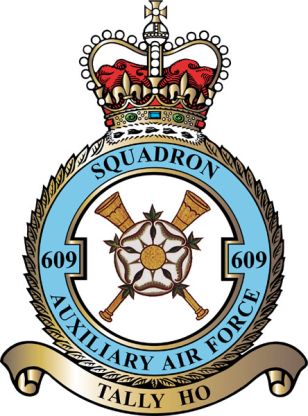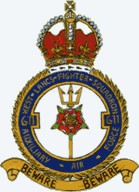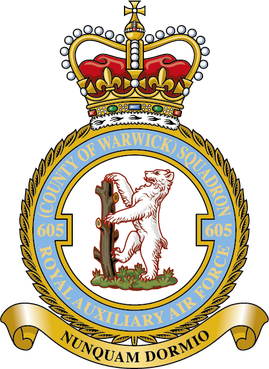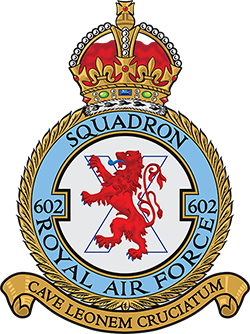
No. 610 Squadron of the Royal Air Force was a Squadron of the Auxiliary Air Force. Comprising very high quality pilots, often ex-RAF officers and occasionally locally based company Test pilots from companies such as de Havilland and Airwork, its pilots were initially part timers who would spend their weekends and spare time flying and practising combat manoeuvres. The squadron was named the "County of Chester" and adopted the motto "Alifero tollitur axe ceres"; which translates as "Ceres rising in a winged chariot", Ceres being the Roman Goddess of Wheat, a reference to Chester's Agricultural sector. Its badge contained the image of a garb.

No. 249 Squadron RAF was a Royal Air Force squadron, active in the sea-patrol, fighter and bomber roles during its existence. It was one of the top scoring fighter squadrons of the RAF in World War II.
No. 213 Squadron was a squadron of the Royal Air Force. The squadron was formed on 1 April 1918 from No. 13 (Naval) Squadron of the Royal Naval Air Service. This RNAS squadron was itself formed on 15 January 1918 from the Seaplane Defence Flight which, since its creation in June 1917, had had the task of defending the seaplanes which flew out of Dunkirk.

No. 453 Squadron is an air traffic control unit of the Royal Australian Air Force. It was established at Bankstown, New South Wales, in 1941 as a fighter squadron, in accordance with Article XV of the Empire Air Training Scheme for overseas service with the Royal Air Force during World War II. No. 453 Squadron saw combat first in the Malayan and Singapore campaigns of 1941–42. Severe aircraft losses effectively destroyed the squadron and it was disbanded in March 1942. A successor unit by the same name was raised in Britain from mid-1942, to take part in fighting against Nazi Germany in Europe until 1945. The squadron was disbanded in 1946. It was re-formed in its current role in 2011.

No. 609 Squadron of the Royal Auxiliary Air Force, originally formed as a bomber squadron and in the Second World War active as fighter squadron, nowadays provides personnel to augment and support the operations of the Royal Air Force. The squadron is no longer a flying squadron, but instead has the role of Force Protection. It is currently based at RAF Leeming, North Yorkshire.

No. 504 Squadron was one of the Special Reserve Squadrons of the Auxiliary Air Force, and today is a reserve force of the RAF Regiment. It was integrated into the AAF proper in 1936. Based at RAF Cottesmore, Rutland, 504 Squadron used a variety of light bombers before being re-tasked to fighters with the Hawker Hurricane in 1939. It subsequently became a Fighter Squadron. Currently No. 504 Squadron no longer has a flying role, but as part of No 85 Expeditionary Logistics Wing of the RAF A4 Force.

No. 607 Squadron is an auxiliary squadron of the Royal Air Force. It was formed in 1930 as a bomber unit in the Auxiliary Air Force and changed in 1936 to the fighter role. It fought in that role during the Second World War in Europe and Asia. After the war, in 1946, the squadron reformed as a fighter unit. Awarded the title Royal Auxiliary Air Force by King George in 1947, 607 Sqn was disbanded with all the other flying units of the RAuxAF on 10 March 1957. It reformed on 5 January 2015, as a General Service Support Squadron (GSS).
No. 666 Squadron was a Royal Air Force Air Observation Post (AOP) squadron associated with the Canadian 1st Army and later part of the Royal Auxiliary Air Force. Numbers 651 to 663 Squadron of the RAF were Air Observation Post units working closely with British Army units in artillery spotting and liaison. A further three of these squadrons, 664–666, were manned with Canadian personnel. Their duties and squadron numbers were transferred to the Army with the formation of the Army Air Corps on 1 September 1957

No. 611 Squadron is a British Royal Air Force squadron. It was first formed in 1936 and was disbanded in 1957 after seeing combat as a fighter unit during the Second World War. It was reformed as a reserve squadron in 2013.

No. 616 Squadron is an active Reserve unit of the Royal Auxiliary Air Force (RAuxAF) assigned to the RAF ISTAR Force at RAF Waddington. It was originally formed as a unit of the British Auxiliary Air Force in 1938, active throughout World War 2 as a fighter unit, becoming the 1st operational RAF unit to fly jets and disbanded in 1957. The unit reformed in its current guise in April 2019 as 616 Squadron Royal Auxiliary Air Force.

No. 605 Squadron was formed as an Auxiliary Air Force Squadron. Initially formed as a bomber unit, it was one of the most successful participants of the Battle of Britain. It also had the distinction of being active during the Second World War at two fronts at a time, when the squadron was split up between Malta and the Dutch East Indies. In its last incarnation as an active flying unit, the squadron served as the first jet fighter unit in the post-war Royal Auxiliary Air Force; 616 having already flown Gloster Meteors during the war. No. 605 Squadron was reformed as a RAuxAF Logistic Support Squadron (LSS) on 1 Nov 2014 within No. 85 Expeditionary Logistics Wing of the RAF A4 Force. On the 1 January 2019, the Reserve Logistic Support Wing (RLSW) was established with 501, 504 and 605 LSS Squadron's moving from No. 85 Wing RAF to form RLSW.
No. 608 Squadron was an Auxiliary Air Force squadron of the Royal Air Force during the Second World War. It flew during its existence as a bomber, fighter and reconnaissance unit and was the only RAF squadron to be equipped with the unsuccessful Blackburn Botha torpedo bomber.

Number 601 Squadron is a squadron of the RAF Reserves, based in London. The squadron took part in the Battle of Britain, during which the first Americans to fly in World War II were members of the squadron.
No. 229 Squadron RAF was a squadron of the Royal Air Force, and is an officially accredited Battle of Britain Squadron. It became No. 603 Squadron RAF in January 1945.

No. 600 Squadron Royal Auxiliary Air Force is a squadron of the RAF Reserves. It was formed in 1925 and operated as a night fighter squadron during the Second World War with great distinction. After the war, 600 Squadron went on to operate jet fighters until 1957. Reactivated in 1999, 600 Squadron is the only RAF Reserve unit within the M25. It is a Headquarters Support Squadron and provides trained part-time reservists to support RAF operations around the world.

602 Squadron is a Royal Auxiliary Air Force squadron. Originally formed in 1925 as a light bomber squadron, its role changed in 1938 to army co-operation and in 1939 to that of a fighter squadron.

No. 615 Squadron was a unit of the British Auxiliary Air Force and later the Royal Auxiliary Air Force between 1937 and 1957.

No. 614 Squadron was originally formed on 1 June 1937 as an army co-operation squadron unit of the Auxiliary Air Force. It served during the Second World War first in this role and later as a bomber squadron. Upon reformation it served as a fighter squadron until the disbandment of the Royal Auxiliary Air Force on 10 March 1957.
No. 612 Squadron RAF was originally formed in 1937 as an Army Co-operation unit, and flew during the Second World War in the General Reconnaissance role. After the war the squadron was reformed and flew in the Day Fighter role until disbanded in 1957. At present the squadron has a non-flying role as a RAF Medical Reserves unit.
The Battle of the River Forth was an air battle on 16 October 1939 between Supermarine Spitfires from No. 602 and No. 603 Squadrons of the Royal Air Force and Junkers Ju 88 bombers of 1. Gruppe Kampfgeschwader 30. It resulted when twelve Ju 88s attacked Rosyth naval base at the Firth of Forth. The raid was the first German air raid on Britain during World War II.
















